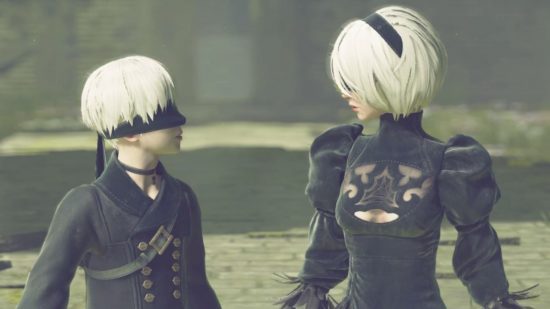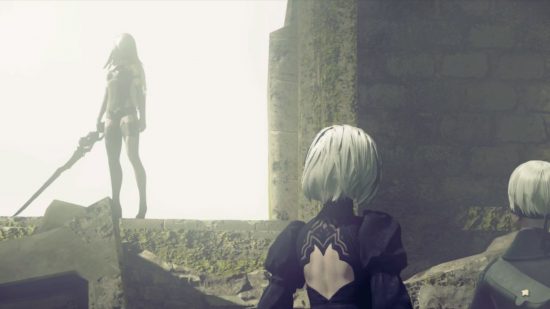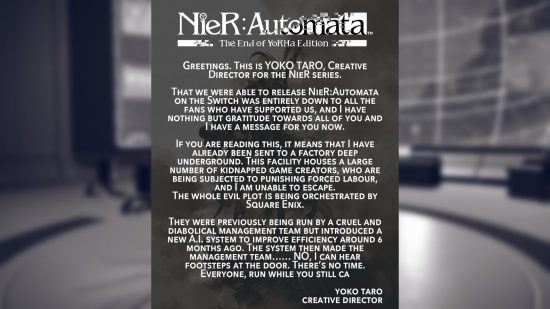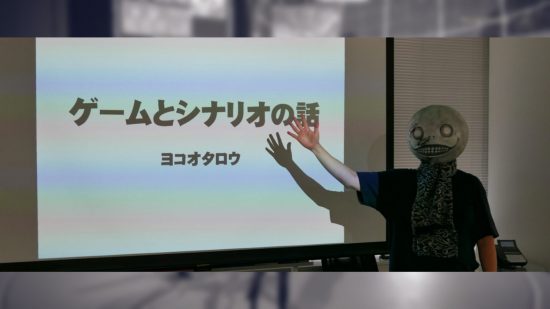When you think about Nier Automata, it’s quite likely you think about Yoko Taro. From background design on Time Crisis II, all the way up to his new project, the Voice of Cards series, the famed Japanese game developer’s biggest and loudest hit is, without a doubt, Nier.
But there’s more to Nier than just one man, of course. Yosuke Saito has produced legendary games like Robot Alchemic Drive and Drakengard, the latter of which was created by Taro and from which the Nier series is a spin-off. Saito and Taro have worked together forever. Then there’s Keiichi Okabe, a composer with a resumé full of classics: Ridge Racer, Tekken, Taiko no Tatsujin, Super Smash Bros., and, of course, the Nier series.
This trio at the top of Platinum Games didn’t buckle down to get Nier Automata on the Switch themselves, however, so we have even more people to thank. Virtuous has become a famed Nintendo Switch porthouse, bringing Bioshock, XCOM, and The Outer Worlds to the console in impressive fashion.
If you read our Nier Automata Switch review, it’s clear that they’ve done it again. Chen Yu and Wang Daijun, both technical directors at Virtuos, helped bring the game to Nintendo’s handheld with very little compromise.
This whirlwind of different input is just the tip of the iceberg of people behind this beloved game. But I can’t exactly talk to everybody. So, I sat down with the brains behind the game’s creation, as well as the tech wizards at Virtuous who made this miracle port, to find out what sort of sorcery they worked. And, as always, Mr Taro was in fine form.
There are two things I wanted to learn about. Firstly, I had sincere technical questions about the port. I’ve been obsessed with Nier Automata since its release, to the point of watching everything I could find about the development, including the great GDC talks available.
So, I start seriously. Did they have to make any compromises to get the game on Switch? It’s quite a demanding game after all. This is where Chen Yu is in the perfect position to enlighten me, and it’s pretty cut and dry.
“We have not compromised on the game system at all,” he says. “The only difference is that we changed the original game’s 60fps frame rate for 30fps. We also tweaked the gameplay slightly on the “Speed Star” sub-quests where time is limited, and the difficulty level is high.”
In that GDC talk I mentioned, Takahisa Taura (above, to the left of Taro) explained that the input lag in the game is tiny. Was this same feeling of responsiveness a focus when porting to the Switch? Wang Daijun helps me out here.
“Yes, for a game with a strong action focus like this one, we always make sure to capture the same response times”, he says. “We have actually left the input logic and the battle system from the original game unchanged. I was constantly optimizing the systems while checking them against the original version and I can guarantee that the Switch version offers exactly the same gameplay as the original.”
My silly tech brain can’t help but dig down into the minutiae. Remember when Assassin’s Creed III came to Switch and sounded awful? That was due to the audio compression, something a lot of Switch games have struggled with. So, was it difficult to keep the fidelity of the score? Mr. Daijun is nice and straightforward about the matter.
“It was. The audio compression was a big challenge for the team”, he says. “We started with the sound engine by using the neon instruction set for optimisation, to improve the engine’s parallel execution effect rate. We then compared the specific scenes that would get the most attention with the original version and worked further optimisation to ensure as close fidelity to the sound quality as we could. Finally, we continued to compare on a scene-by-scene basis when we were doing the compression, in order to balance out the quality and the system’s capabilities.”
The amazing attention to detail that went into this port is astounding. But with all the struggles to keep the audio fidelity high, is Keiichi Okabe (above) worried about players listening to his grand score through the Switch’s tiny speakers?
“The way players hear sound when playing consumer games changes completely based on the hardware environment they use, and that has always been the case, so I was not particularly worried this time”, he says. “I am sure that there will be players who are interested in the sound while playing on Switch and decide to play using headphones, so I would be delighted if there are a lot of people like that.” I don’t know about you, but I had my headphones in.
So, the Nier Automata Switch port is excellent due to Virtuous’ attention to detail. Comparing scene-by-scene to ensure it matches up to the console is one thing, but getting it to run at a solid 30fps with decent fidelity is another. But they managed it.
The second thing I wanted was to learn more about the game’s creators, primarily Yoko Taro. He’s a pretty hilarious presence among game developers, only appearing in public behind the famous Emil mask from the game. From tweeting about loving sausages and beer (perhaps joining the legend Hideo Kojima in sharing such love) to talking about Square Enix’s sinister plots to kidnap game developers, he’s a character, to say the least.
So, I keep it simple: “I remember you saying ‘I love sausage and beer’ on Twitter. What’s your favourite beer? What’s your favourite sausage?” Turns out Mr Taro is taking it easy.
“My doctor has told me to cut back on the booze, so I currently drink a lot of non-alcoholic beer, but most of the non-alcoholic stuff you can get in Japan tastes awful. That is why I drink an authentic German non-alcoholic beer called Clausthaler. Germany is just the best!” I wonder if he went to Gamescom this year, he would’ve loved it (as I’m sure I would’ve too).
It’s not just Germany though. “You can’t eat good sausages here in Japan either. The only proper sausage company that sells here is Johnsonville, so I eat their sausages a lot. I love big fat sausages. America is just the best!” Yoko the Cosmopolitan.
As I explain in my Nier Automata review, I was very unwell when I played the game prior to release. As I lay in bed, medicated to the Nth, my brain swirled with memories of half a decade of love for the game – secret room hoaxes, Tinder convincers, GDC talks, risqué art, sausage and beer…
And a couple of days later, I got the chance to ask some questions about the game. Uh oh… this isn’t going to end well, I just want to ask about nonsense. I hope the team is fine with that.
Turns out they were. So, after getting the technical stuff out of the way, I let loose. One of those memory swirls was the story of the Tinder user who convinced people to buy NieR: Automata. Did it help them think up new marketing strategies? Maybe a NieR dating app? Yosuke Saito (below) isn’t against it, but I can’t hear much enthusiasm either.
“I saw that news and thought I might start a Tinder account too…” he says. “A NieR dating app would be cool, but I don’t think I would be allowed to join it, so I have given up on the idea…” A shame, I guess, for any Nier fans looking for love.
Perhaps, instead, these Nier fans find love in one of the series’ beloved characters – 2B, 9S, and A2. Some go so far as to recreate them, either through cosplay or with artistic skill. Did they ever expect the art community to recreate their characters in so many ways, some of them risqué?
“I am nothing but grateful for all the art that people drew”, Yoko says. “It is not just the well-drawn stuff either. All the art is great, including the lewd stuff and the badly drawn ones too.” Hear that? Anyone can draw 2B and get the creator’s approval, even if you’re rubbish at drawing. Lovely.
Yosuke Saito finds the whole thing quite surprising. “I did not think it would go this far. I really am grateful for all the fan art and cosplay that celebrates the world of NieR. I love looking through it all, including the risqué stuff.” Horny or otherwise, do your thing artists.
One person you’d struggle to draw is Yoko Taro himself. He doesn’t appear in public without wearing the Emil mask. Does that make his life a hassle? Can he play Switch while wearing that Emil mask? I assume he can’t see. Well, turns out there’s another strange Square Enix conspiracy brewing, according to the man himself.
“So let me get this straight. By saying I am not able to see the screen when wearing the Emil mask, are you implying that Yoko Taro cannot see development screens or do any debugging, and that basically he doesn’t do anything and is just a clown-like figure who was created to promote games? Sorry to disappoint you, but the truth behind that is one of Square Enix’s biggest secrets, so I cannot answer either way.” Referring to himself in the third person just makes the whole mystery even grander.
But beyond all this silliness, the sense of playfulness around all this nonsense, Taro, Saito, and Okabe have all had incredibly long careers. What do they think about when they look back on them? What does the future hold for the Nier series and its creators? Well, that turned things slightly morbid.
“If this one sells well then we would have to think of doing something about that…” Saito says. “Having said that, we also have to look at doing new games in the series, so what should we do? Mr. Yoko, Mr. Okabe and myself will probably not be alive for much longer, so I think we need to start cutting down our options.”
This reads surprisingly grave, but I suspect it’s more cheery and humorous. Does the Nier series die with its creators? Who knows. But they’re ready to make even more games – and if Nier Automata sells well on Switch? Then we might get some more. That’s how they get ya.










